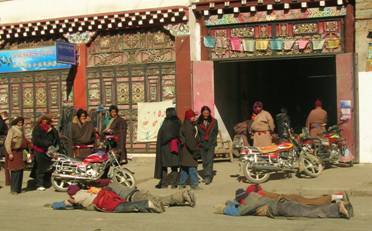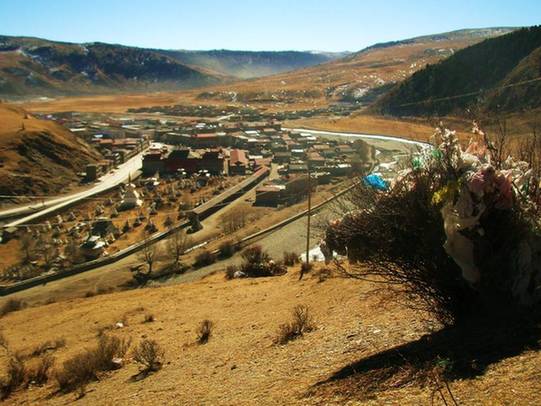The place the Gods like: A temple town in Kham
|
|
|
Torn prayer flags are draped over a bush on one of the hills overlooking Tagong. |
Tagong, Sichuan. I sat in Sally's Café on a frigid January morning watching the hubbub of the only street in town while I waited for my yak stew to finish cooking. I was 11,700 feet above sea level and the sound of the pressure cooker squealing in the background did not help my altitude-induced headache. Townfolk strolled around in fur-lined tunics, browsing the open-air shops. Most people let their long sleeves dangle loosely at their sides, walking around with their arms pulled inside and folded across their chests for warmth. Nomads rode in on meticulously decorated motorcycles with leopard-pattern saddles and charms hanging from the handlebars.
Sally, the portly restaurant matron, told me that I was the only tourist she had seen in a long time, and that most people come when it is warmer and nomads are grazing their herds in the grasslands that surround the main town. Indeed, it was not the most comfortable time to visit – at the guesthouse where I was staying there was no running water because the pipes were frozen. The bathroom floor was partially iced over. The only source of heat in the house was a wood stove in the kitchen. It was so cold that I only stayed for a day.
I may have been the only tourist, but there were plenty of other visitors – pilgrims, who arrived on foot from the south. They wore brown aprons draped over their knees and wooden planks tied to their hands. With every few steps they fell to their knees and then prostrated themselves in the direction of Tagong temple, taking advantage of the icy surface to slide several feet with each prostration. Every once in a while a coal truck barreled down the road, missing the pilgrims by just a couple of feet. They were inching their way towards a very special image of the Buddha in the prayer hall of the temple that is identical to the one in the Jokhang Temple in Lhasa.
The Tagong Buddha purportedly dates to the Tang Dynasty. In the year 640, Princess Wencheng of Tang began a long westward journey to Lhasa to marry Songtsen Gampo, the king of Tibet. Tang China and Tibet had been fighting on the shores of Lake Kokonor, and this royal marriage brought long-lasting peace.
According to legend, as the princess' caravan passed through the region of Kham, a likness of Sakyamuni Buddha that they were carrying fell off its cart in Tagong. The princess took this as a sign that she was meant to leave a Buddha there, so she had an identical statue built and then continued her journey. Later she and the king would erect one hundred and eight temples throughout Tibet, including a temple in Tagong to house the Buddha that she had left there. Tagong Temple now belongs to the Sakya sect of Tibetan Buddhism. The name of the town in Tibetan, Lhagang, is said to originate from the words "lha ga" in Tibetan, meaning "Gods are happy." As the sign in front of the temple declares, Tagong is the "place the Gods like."
I visited Tagong as part of a trip through the mountains of western Sichuan, known as Kham to Tibetans. Most travelers reach Tagong via a two-leg journey: first an early-morning bus that covers 350 kilometers from Chengdu to the mountain city of Kangding, and then a three-hour bus from there to Tagong.
The bus left Kangding before dawn on a Saturday morning and I watched the sun rise over snowy mountains. Between the winding roads and the gorgeous scenery, I felt intoxicated as I gazed out the window. The Tibetans on the bus – Khampa, as the people of Kham are called – were mostly quiet, and they were just as likely to sing or chant as to talk. Khampa men are sturdily built, historically known to be horsemen and warriors. The women are strong too, and spend much of their time doing manual labor, perhaps even more so than men. Wander through any pastoral setting in Kham and you will see women farming or hauling bushels of barley on their backs.
A young Tibetan man in the back was telling riddles to the little Chinese boy next to him, and every once in a while he would burst out in song. He sang mostly popular folk songs, including "Love Song of Kangding" and "Drolma":
You have the name of a flower, pretty maiden Drolma,
You have the smile of a flower, pretty maiden Drolma,
You are like a free bird singing on the grasslands,
You are like a fluttering butterfly twinkling among the shrubs
Had I blinked I might have missed Tagong. It is little more than a flash on the road between Kangding and Bamei. As the bus rolled into town, a sign in Chinese on what might have been a schoolhouse read:
"A small place. A faraway place. Learning will make it into a good place."
I disembarked in the town square by the gate to the temple where a couple of Tibetan mastiffs were basking in the sun, their black fur speckled with dust. First I dropped off my bags at JyaDrolma's Guesthouse, and then at midday I visited the temple and the monastery, where young monks sat on the ground and ate tsampa with their fingers out of metal bowls. Climbing a hill, I looked down at the yard of white stupas and watched people – especially old ladies – circumambulate the temple as they turned its large prayer wheels in passing. The oxbow curve of a frozen river glistened in the sun. I wondered what it would be like to come live in Tagong. It turns out that I would not be the first American to do that.
On the day I left Tagong I met a woman named Angela who lived there. She had grown up in a small town in Colorado and attended Williams College in Massachusetts. After graduating she joined the Peace Corps and was placed in Chongqing as a teacher. A few months after moving to China she took a hiking trip to west Sichuan and met a young Tibetan nomad named Djarga. Eventually they married and had a child together. She now runs a handcrafts co-operative from Tagong, helping the people of Kham to market their traditional crafts – handbags, garments, tsampa containers and much more – to a foreign demographic. She works with multiple nomadic clans in the area, including Shamalong, Reseer, Raleh and her husband's clan of Genup. In the near future she is hoping to open up a shop in Tagong.
She and her two year-old daughter Somtso were on their way to Chengdu to accompany their friend Soko, a young woman who needed a dentist. Soko had not traveled farther than Kangding in 20 years and was eager to return to Tagong as quickly as possible. Others on the bus were also seeking medical care.
 |
|
Pilgrims prostrate themselves on the way to Tagong Temple. |
But people smile in Tagong, even in the winter. They leave the warmth of their wood stoves and trickle out of their stone houses as the town thaws out in the middle of the day, to browse, shoot pool and gossip. In the summer the grasslands will be dotted with yaks, cows and felt tents, and in the autumn droves of nomads and tourists will come to watch the annual horse racing festival. I hope to come back and see that, but it was nice to have a whole Tibetan town to myself for one cold winter day in January.
To buy Kham Tibetan crafts, arrange a tour or volunteer in Tagong, check out Angela's website at www.definitelynomadic.com.
 0
0 








